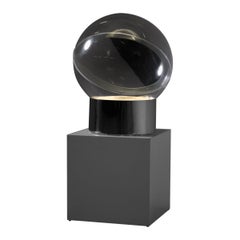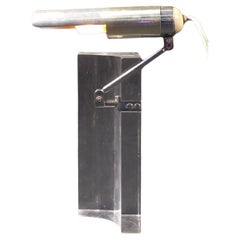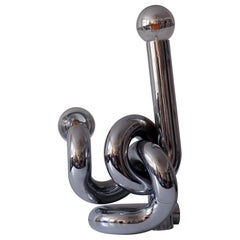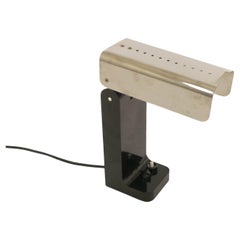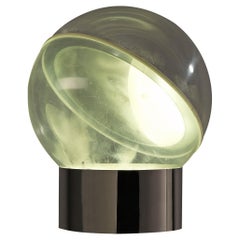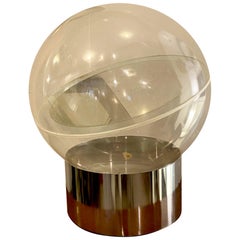Filippo Panseca Table Lamps
to
2
2
Height
to
Width
to
2
2
2
2
2
2
2
2
1
1
2
2
2
2
2
3
253
252
237
215
Creator: Filippo Panseca
XL Sphere Table Lamp ‘Model 4043’ by Filippo Panseca for Kartell, Italy, 1960s
By Kartell
Located in Rotterdam, ZH
Table / floor lamp ‘Model 4043’ by Filippo Panseca for Kartell, Italy 1968. Two models were produced, this is the rare largest version. Interesting radical design...
Category
1960s Italian Mid-Century Modern Vintage Filippo Panseca Table Lamps
Materials
Stainless Steel
Filippo Panseca for Arteluce, Articulated Desk Light, 1960s
By Arteluce
Located in Wargrave, Berkshire
Filippo Panseca for Arteluce, Articulated Desk Light, 1960s.
The design comprises a clear perspex block with articulated aluminium arm and shade. Both the arm and the shade adjust ...
Category
1960s Italian Mid-Century Modern Vintage Filippo Panseca Table Lamps
Materials
Aluminum
Related Items
Sculptural Table Lamp or Floor Light 'Bruco' by Giovanni Banci, 1960s, Italy
By Giovanni Banci
Located in Munich, DE
Gorgeous Mid-Century Modern light sculpture / table or floor lamp 'Bruco'. Designed by Giovanni Banci, Firenze, Italy, 1960s.
Executed in massi...
Category
1960s Italian Mid-Century Modern Vintage Filippo Panseca Table Lamps
Materials
Chrome, Steel
$8,142
H 24.41 in W 16.54 in D 12.6 in
Black Vademecum table lamp by Joe Colombo for Kartell, 1960s
By Joe Colombo, Kartell
Located in Rotterdam, NL
Black Vademecum (model 4034) table lamp, designed by Joe Colombo in 1968 and manufactured by Kartell.
The Vademecum lamp is made of a plastic base and a stainless steel arm / shade....
Category
1960s Italian Mid-Century Modern Vintage Filippo Panseca Table Lamps
Materials
Steel
Italian 1960s Marble Column Hollywood Regency Table Lamp
Located in Antwerp, BE
Rara Italian marble sculptural midcentury table lamp.
Dimensions base:
Width 24 cm, depth 12 cm, height 62 cm, without socket 55 cm. Weight 8 kg.
Height with shade 85 cm, diamet...
Category
Mid-20th Century Mid-Century Modern Filippo Panseca Table Lamps
Materials
Marble
Gino Sarfatti for Arteluce Vintage Double Wall Light Model 237/2, 1960s
By Gino Sarfatti, Arteluce
Located in Morazzone, Varese
Gino Sarfatti for Arteluce Double Wall Lights Model 237/2 in Glass Metal, 1970s
Original vintage wall light, model 237/2 by Gino Sarfatti for Arteluce, Milano.
Two spherical diffuse...
Category
1950s Italian Mid-Century Modern Vintage Filippo Panseca Table Lamps
Materials
Metal
$1,664
H 7.88 in W 13 in D 9.06 in
Sculptural Mazzega Murano Glass Mid-Century Table Side Lamp, Italy, 1960s
By Mazzega
Located in Vienna, AT
A beautiful table or side lamp, made of Murano glass, manufactured by Mazzega Italy in the 1960s. Consists of a metal base and three huge, solid, domed handblown, clear and white Mur...
Category
20th Century Italian Mid-Century Modern Filippo Panseca Table Lamps
Materials
Metal
Chrystiane Charles for Maison Charles Signed Brass Fern Table Lamp circa 1960s
By Maison Charles, Chrystiane Charles
Located in Landau an der Isar, Bayern
Chrystiane Charles for Maison Charles early rare signed model on a black marble base in cast brass / bronze table lamp with original brass meta...
Category
Mid-20th Century French Mid-Century Modern Filippo Panseca Table Lamps
Materials
Brass, Bronze
$5,404 Sale Price
30% Off
H 28.75 in Dm 6.3 in
Gino Sarfatti for Arteluce flush mount light 3001/50, Italy circa 1960s
By Gino Sarfatti, Arteluce
Located in Brooklyn, NY
Gino Sarfatti for Arteluce flush mount ceiling light.
Model 3001/50
Prismatic glass, chrome plated aluminum, painted metal.
Remains of Arteluce sticker.
Made in Italy in 1950s.
Takes...
Category
1960s Italian Mid-Century Modern Vintage Filippo Panseca Table Lamps
Materials
Metal
$6,800 Sale Price
20% Off
H 4.75 in Dm 19.75 in
Huge Ceramic Floor & Table Lamp by Tommaso Barbi, Italy, 1960s
By Tommaso Barbi
Located in Niederdorfelden, Hessen
Elegant rare, huge Tommaso Barbi ginger jar ceramic lamp made in Italy in the 1960s. Crème ivory colored ceramic base, original fabric shade wi...
Category
1960s Italian Mid-Century Modern Vintage Filippo Panseca Table Lamps
Materials
Ceramic
Italian Table Lamp, 1960s
Located in bruxelles, BE
White Italian metal lamp. Wear due to time and age of the lamp
For shipping, request us for receive the best price.
Category
1960s Italian Mid-Century Modern Vintage Filippo Panseca Table Lamps
Materials
Metal
Castiglioni Metal "Light Ball" Italian Sconce for Arteluce and Flos, 1960s
By Flos, Arteluce, Achille Castiglioni
Located in Roma, IT
Incredibly rare first edition of the famous "Light Ball" applique by Castiglioni in white metal and opal glass. This fantastic lamp was designed by Castiglioni for Arteluce and produced in Italy by Flos in the 1960s.
This fantastic lamp was designed by Castiglioni for Arteluce and produced in Italy by Flos in the 1960s.
This fantastic light is unique because of the materials, made of white enameled metal and opal glass. It can be mounted on the wall or on the ceiling.
The wall light has been tested, it uses an E27 light bulb. It is signed on the backplate by both Arteluce and Flos.
A fantastic piece that will grace a mid-century living room or bathroom.
Measures (cms):
diameter - 42
height - 32
Literature: Casa Amica, 27 June 1972, p. 105 Octagon 30 September 1973, p. 149 Sergio Polano, Achille Castiglioni all the works, Electa, Milano, 2001, p. 224 Giuliana Gramigna, repertoire 1950-2000, Allemandi, Torino, 2003, p. 121.
The beginnings of Flos (meaning “flower” in Latin) blossomed from a brilliant idea: to create objects, starting with a light bulb, that would change the way of life for both the Italian market and the foreign markets.
Dino Gavina and the small Eisenkeil manufacturing facility in Merano, had already been creating furniture alongside design masters such as Achille and Pier Giacomo Castiglioni, Afra and Tobia Scarpa. But by the early 1960s, Gavina became convinced the time had come to create new lamps.
Using the same technology – conceived in the USA and tested at Eisenkeil – used for the Cocoon lampthe Castiglioni brothers and the Scarpa duo began creating lamps such as the Taraxacum or the Fantasma, with many other beautiful and surprising lamps to follow.
And so, from day one, Flos was already reinventing the idea of artificial lighting.
Achille Castiglioni (born February 16, 1918, Milan–died December 2, 2002, Milan) was a prolific furniture, lighting, and product Italian designer renown for his ironic, joyful, creative and functional designs that, at times, intersected with ideas explored by conceptual artists.
Achille Castiglioni was born into a family with deep appreciation for the arts, as he was the third son of sculptor and coin engraver Giannino Castiglioni and his wife Livia Bolla. He first studied the classics at the Liceo Classico Giuseppe Parini, but then switched to study art at the Accademia di Belle Arti di Brera in Milan. In 1937, he decided to follow the steps of his two elder brothers, architects Livio and Pier Giacomo Castiglioni, by enrolling in the Faculty of Architecture at the Politecnico di Milano, graduating in 1944–after having to interrupt his studies when he was stationed in Greece and Sicily during World War II.
In 1944, immediately after graduating, Achille Castiglioni joined his brothers Livio and Pier Giacomo in the design studio that they had founded with Livio’s classmate Luigi Caccia Dominioni in 1937 in Milan. Fortunately for Achille, from the very beginning Livio and Pier Giacomo decided to focus almost entirely on designing exhibitions, furniture, housewares, and appliances since architectural commissions were difficult to come by during the war. This product-design focus, and the deep fraternal bound among the three brothers, would later allow the young Achille to experiment early in his career with emerging techniques and new materials that could communicate a fresh aesthetic sensibility suited for the positive outlook of the post-war European market.
The Castiglioni brothers’ important collaboration with Phonola and Brionvega
In 1940, Pier Giacomo Castiglioni, Livio Castiglioni, and Luigi Caccia Dominioni, in collaboration withe the Phonola company, presented in the VII Triennale di Milano (Milan Triennial), titled Exhibition of the Radio, a research study of radio devices that included the Fimi Phonola 547 radio, the first radio encased in Bakelite instead of wood. Shortly after the exhibition, Luigi Caccia Dominioni suspended his professional activity to serve in the military during World War II and left the studio.
The development of the FImi Phonola 547 radio would prove fruitful for the three brothers, as it allowed Livio Castiglioni to cement his role as the leading design consultant for Phonola from 1940 until 1960, and for Brionvega, from 1960 until 1964. These relationships brought in further collaboration among the three brothers, and would eventually result in several designs for radio and sound appliances with innovative materials and shapes for which Achille Castiglioni played a key role, such as the RR 226 stereo system for Brinovega (1965), the radio phonograph RR 126 for Brinovega (1965), and the radio and record player RR 128 for Brionvega (1966)
In 1952, Livio decided to build his own practice, independent from Achille and Pier Giacomo, to pursue a deeper exploration of radio waves, music, and technology. But the three brothers would continued to collaborate closely in several projects, and the partnership between Achille and Pier Giacomo became so tight that from 1952 until 1968, when Pier Giacomo died, they co-authored most of their designs.
Achille Castiglioni Long Career as Light Designer
During this period, the Castiglioni brothers participated in the Italian Exhibition of Furniture (RIMA), where they successfully introduced a series of curved-plywood furniture, and presented important designs, such as the Tubino lamp (1949), originally produced by Italian light maker Arteluce from 1949 until 1974, and reintroduced by FLOS since the late 1970s; and the Luminator lamp (1955), originally produced by Gilardi & Barzaghi, but reintroduced by FLOS in the late 1960s.
A new, successful, and long-lasting collaboration developed in 1960, when Pier Giacomo and Achille Castiglioni were reached by entrepreneurial Italian designer Dino Gavina and business man Arturo Eisenkeil with the idea to create a completely new kind of lighting fixtures utilizing a polyamide. The material, which they called “cocoon,” in the hands of the Castiglioni brothers would become a popular and iconic innovation in the 1960s and serve as the successful foundation of Italian lighting company FLOS–founded by Gavina and Eisenkeil in 1962.
Pier Giacomo and Achille Castiglioni designed a series of “cocoon” lights utilizing the spray-on polyamide plastic as a coating layer onto a metal frame. Among the most popular Castiglioni “cocoon” lights are: the Taraxacum and the Viscontea ceiling lamps (1960), and the Gatto table lamp (1961).
Other of the important lamp designs by Pier Giacomo and Achille Castiglioni for FLOS are the Beehive -or Splügen Braü lamp (1961), Toio –or Toy lamp...
Category
1960s Italian Mid-Century Modern Vintage Filippo Panseca Table Lamps
Materials
Metal
$1,544
H 12.6 in Dm 16.54 in
Large Blue LT 216 Table Lamp by Carlo Nason for A.V. Mazzega, 1960s
By Carlo Nason, AVMazzega
Located in Rotterdam, NL
Large blue LT 216 table lamp designed by Carlo Nason and manufactured in the 1960s by Murano glassmaker A.V. Mazzega. The lamp is made of white opaline glass globe and a blue Murano glass base...
Category
1960s Italian Mid-Century Modern Vintage Filippo Panseca Table Lamps
Materials
Murano Glass, Opaline Glass
Gino Sarfatti Table Lamp for Arteluce
By Arteluce, Gino Sarfatti
Located in bergen op zoom, NL
Table lamp model 600C designed by Italian lighting master Gino Sarfatti for Arteluce in 1966.
This is an early edition Arteluce, however the labels were often polished off
The ...
Category
1960s Italian Minimalist Vintage Filippo Panseca Table Lamps
Materials
Faux Leather
Previously Available Items
Filippo Panseca for Kartell Table Lamp '4044' in Perspex and Neon
By Kartell
Located in Waalwijk, NL
Filippo Panseca for Kartell, table lamp, model '4044', chrome-plated brass, perspex, neon, mirror, Italy, 1968.
Futuristic spherical lamp designed by Italian designer Filippo Pansec...
Category
1960s Italian Post-Modern Vintage Filippo Panseca Table Lamps
Materials
Brass, Chrome
Filippo Panseca for Kartell "4043" Table Lamp, Italy, 1968
By Kartell
Located in Naples, IT
Rare Space Age table lamp by the Italian designer Filippo Panseca in chrome, plexiglass and mirrored glass. Kartell, Italy, 1968
Very nice mood light.
Category
1970s Italian Mid-Century Modern Vintage Filippo Panseca Table Lamps
Materials
Chrome
Light by Architect Filippo Panseca with Original Steel Base, 1960s
Located in Los Angeles, CA
Two separate pieces--this mod light sits atop a steel base and is ready to be noticed.
Category
1970s Italian Vintage Filippo Panseca Table Lamps
Materials
Steel
Filippo Panseca table lamps for sale on 1stDibs.
Filippo Panseca table lamps are available for sale on 1stDibs. These distinctive items are frequently made of plastic and are designed with extraordinary care. There are many options to choose from in our collection of Filippo Panseca table lamps, although brown editions of this piece are particularly popular. Many of the original table lamps by Filippo Panseca were created in the mid-century modern style in italy during the 1960s. If you’re looking for additional options, many customers also consider table lamps by Gianni Celada, Fidenza Vetraria, and Superstudio. Prices for Filippo Panseca table lamps can differ depending upon size, time period and other attributes — on 1stDibs, these items begin at $3,644 and can go as high as $8,000, while a piece like these, on average, fetch $4,037.
